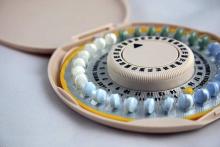SCOTTSDALE, ARIZ. – Experts have not reached consensus on prescribing oral contraceptives for women with migraine, revealing the need for better studies of stroke risk in these patients, said Dr. Huma Sheikh, a neurologist at Brigham and Women’s Hospital in Boston.
“During the years that women are most likely to need a reliable form of birth control, the prevalence rates of migraine are also considerable,” Dr. Sheikh said at a symposium sponsored by the American Headache Society. The annual prevalence of migraine is about 18%, and most cases occur in women, she noted. “What is not known is how much these two conditions overlap, and who will develop adverse cardiovascular and cerebral outcomes, including stroke.”
Taking combined oral contraceptives can increase stroke risk, although the absolute rate of stroke in oral contraceptive users remains low at 5-11.3 events per 100,000 woman-years. Migraine with aura increases the risk of stroke by 2.3-3.6 times in women younger than 45 years. And in past studies, taking combined oral contraceptives increased the odds of stroke by 5-17 times in women with migraine, she said.
These findings led the World Health Organization and the American Congress of Obstetricians and Gynecologists to regard migraine with aura as an “absolute contraindication” against the use of combined oral contraceptives, Dr. Sheikh said. “But these recommendations are really based on previous studies that included both low-dose and high-dose oral contraceptives that may not be pertinent to this new era,” she said. “The individual studies had low power, and heterogeneity is a problem.”
Unlike WHO and ACOG, the International Headache Society recommends assessing risk individually when deciding whether to prescribe oral contraceptives for women who have migraine with aura, Dr. Sheikh noted. The IHS advises clinicians to identify and treat other risk factors for stroke, such as hypertension and hyperlipidemia; to diagnose the subtype of migraine; to advise smokers to quit; and to consider contraceptives without ethinyl estradiol for women who have multiple risk factors for stroke.
For women with migraine without aura, WHO and ACOG have cited no contraindication against oral contraceptives as long as patients are under 35 years of age. But both organizations state that the risk usually outweighs the benefits in older women. And the IHS again recommends an individualized risk assessment, she said.
“There is a need to develop an updated guideline for the use of hormones in women with migraine,” Dr. Sheikh emphasized. She is planning a systematic literature review to determine if the previously described increased risk of stroke in young women with migraine still holds true for newer, lower-dose estrogen oral contraceptives and oral contraceptives that contain progestin, she said. Her review also will assess the purported link between migraine or migraine with aura and other cardiovascular outcomes, such as myocardial infarction and overall mortality, she added.
Dr. Sheikh declared no conflicts of interest.


